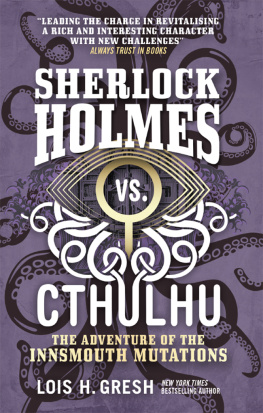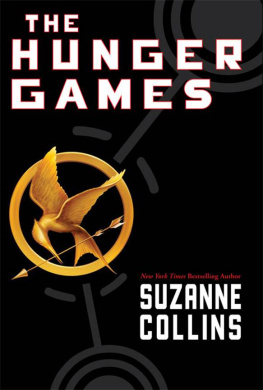



Suzanne Collins, The Hunger Games, Scholastic, Inc., 2008; edition referenced throughout The Hunger Games Companion is the first paperback printing, September 2009.
Suzanne Collins, Catching Fire, Scholastic, Inc., 2009; edition referenced throughout The Hunger Games Companion is the first edition, September 2009.
Suzanne Collins, Mockingjay, Scholastic, Inc., 2010; edition referenced throughout The Hunger Games Companion is the first edition, September 2010.
References to Web sites may have changed or disappeared between the time this book was written and when it is read.

I n dystopian post-apocalyptic novels, a remnant of humanity survives against the odds in situations ranging from nuclear wars to environmental meltdowns; invasions by aliens, zombies, and other monsters; plagues; chemicals; genetics gone wild; supermassive black holes that devour us; earthquakes; volcanoes; and even human-eating plants. Many of these scenarios are man-induced horrors: the nukes, biological and chemical wars, genetic engineering, global warming, pollution, corporate and government greed. In the real world, if a few people survive such an apocalypse, then theres only one way to completely obliterate the human race: The survivors must kill each other off.
Enter author Suzanne Collinss The Hunger Games and its two sequels, Catching Fire and Mockingjay . While the first two books in the series focus on annual gladiatorial Hunger Games and then the Quarter Quell, the third book is essentially about war. Originally aimed at teens aged twelve and up, the series quickly grabbed hold of everyone: twelve, thirteen, fourteen, twenty-five, thirty-five, fifty. It doesnt matter how young or old you are, the messages are the same. If humans arent careful, we may blow ourselves into oblivion by wars, cruelty, the lust for power, and greed. Children are the future of the human race. If we kill our children, who will be left?
What better way to make these points than to postulate an apocalypse followed by war and rebellion, and then to pit the losers children against each other in the Hunger Gamesannual battles to the death? As if the Hunger Games dont kill enough children, the Capitol then pits the survivors against each other in the Quarter Quells.
In general, dystopian post-apocalyptic fiction is wildly popular these days. The novels are bleak, dismal, poignant, sad. These arent comedies. The genre tends to send the warning that, if we dont wake up and stop killing each other, if things dont changeand soonwe might face the nightmares of the characters in the books.
Suzanne Collinss warnings are dished out to us up front and close as if through a magnifying lens. She gives us a heroine, Katniss Everdeen, who is remarkably like many young girls hope to be: Shes brave, considerate, kind, intelligent, quick-witted, courageous, and very resourceful. Yet she lives in a world where all hope has been lost, where people eat pine-needle soup and entrail stew just to survive; where Peacekeepers beat and whip her neighbors and friends for nothing more than hunting and sharing much-needed food; where children are selected each year by lottery to slaughter each other in the Hunger Games, a gladiatorial arena that merges the ancient Roman games with reality television. Truly, this is a world in which the term, survival of the fittest, has immediate and lethal meaning.
The books are international bestsellers, and Suzanne Collins has been applauded by everyone from Stephen King to The New York Times Book Review to Time magazine. As of this writing, more than 8 million copies of all three books in the trilogy are in print. The first novel, The Hunger Games , has been on The New York Times Bestseller List for 130 weeks. Suzanne Collins is one of Entertainment Weekly s 2010 Entertainers of the Year. The books are #1 USA Today bestsellers, #1 Publishers Weekly bestsellers, and top many other prestigious literary award lists, as well.
By the time you start reading this book (the one in your hands now), youll be anxiously anticipating the first Hunger Games movie. You may read The Hunger Games Companion multiple times, especially after March 2012 when The Hunger Games film is in theaters, with Lionsgate at the helm, Jennifer Lawrence starring as Katniss Everdeen, Josh Hutcherson as Peeta Mellark, and Liam Hemsworth as Gale Hawthorne.
This book, The Hunger Games Companion , is an unauthorized guide to Suzanne Collinss excellent trilogy. It examines all the subjects that I find fascinating about the books, topics not covered anywhere to date on the Internet or in any other book.
I assume that readers of this book have already devoured The Hunger Games seriesmany of you multiple times. I assume you know the plots, you know about Katniss and Peeta and Gale, about Buttercup and Prim and Rue, and so forth.
My goal is to generate discussion about The Hunger Games trilogy: the characters, the settings, the storylines, and also about subjects ranging from war to repressive regimes to hunger to the nature of evil itself. Every topic is set against the backdrop of and intertwined with The Hunger Games books and characters.
For example, chapter 2 parallels the Capitol of Panem with repressive regimes in our real world. Along with detailed examples, I pose the question: Could the world depicted in The Hunger Games really happen? Are we facing Big Brother, the end of privacy, dehumanization, and too much government control over our lives? Have the rich become too rich, and are most of us much too poor? Youll be surprised at the answers.
Another example: Chapter 4 draws direct and in-depth parallels between the real gladiators in ancient Rome and the tributes of Panem. While the Capitol is indeed evil to send twenty-four children into the arena every year, the ancient Romans were much worse: They killed many thousands of men, women, children, and animals at a time using torture techniques that go well beyond the horrors of The Hunger Games trilogy. Their vanity and banquets were on par with the Capitols: They feasted and laughed, drank wine and fussed with their clothing.
And how about hunger? Is the starvation in all the districts of Panem any different from starvation in our own, all-too-real world? Is it possible to live on meager amounts of grain and oil? In chapter 3, youll learn how long a typical person can exist on such small allotments of food and the effects on children of this level of malnutrition and starvation. If the Capitol needs the districts to provide it with textiles, food, coal, and other goods, shouldnt it feed its slave workers sufficiently to enable them to work?
As for reality television, public relations experts, paparazzi, fashionistas and stylists, and obfuscation of the truth, chapter 9, Hype Over Substance, shows you how The Hunger Games is a mirror of modern times.
In this book, youll learn about the muttations and how they might be engineered, the mockingjays and how they might mimic elaborate melodies and sounds, the trackerjacker poison and how it might work, and many other topics.
Next page
















